Last updated: June 27, 2017
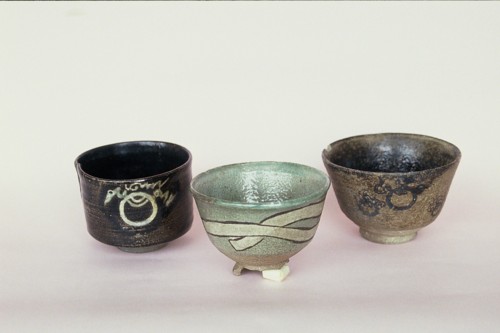
Tamagawa-yaki green tea bowl
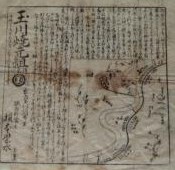
Promotional leaflet for Tamagawa ware
The Enomoto family, located near Koshoji Temple in Sakahama, has a collection of pottery called ``Tamagawa ware'' that was fired in this area in the late Edo period. The Enomoto family had been farming for generations in Sakahama Village, but since the time of Rihei (who lived in the Genroku era), they have been making pots and pots using clay from nearby areas during the farming off-season. It is said that he baked miscellaneous utensils such as mortars, and was called by the trade name ``Dobin-ya.'' The fourth generation, Rihei, went to Seto and Kyoto to train as a pottery artist, learned the local pottery making techniques, and moved to Sakahama Village in 1834. After returning home, I started making pottery in Inagi. After that, Rihei began making Tamagawa ware with the trademark Tamain, and did a prosperous business. He uses the names Enomoto Shisui and Chofuken Shisui.
According to the woodblock-printed flyer promoting Tamagawa ware that remains in the Enomoto family, the clay began firing around Daimaru Kawaragayato, and the "tama" stamp on the Kokubunji tile (meaning Tama District) was first used. ) was used as a trademark. Also, at that time, many fake Tamagawa ware products were on the market, and it is said that the Enomoto family was the original. The promotional text includes a map showing the way to the Enomoto house.
Enomoto Shisui died in 1865, but Shisui's son also took the name Enomoto Shisui, and Tamagawa ware itself was in circulation until the middle of the Meiji period. It's possible. However, many of the works from the Meiji period were imitations of pottery from other countries, and the works of the first generation, Shisui, are said to be superior.
All of the Tamagawa ware that remains in the Enomoto family today is Rakuyaki, including matcha tea bowls, incense containers, jugs, small plates, engravings, prototypes, saggers, and wooden items. There are things like Figo. Matcha tea bowls are the most numerous and the centerpiece of his posthumous works, but among them is the iron-painted tea bowl with a pattern of jackago and nunosarashi (the piece in the center of the photo on the left above). It is a representative masterpiece. The most typical incense gong is the pentagonal bellflower shape, which is similar to celadon porcelain. There are also tortoise-shaped incense containers and round incense containers with Gosu paintings. Other items include the crane, pine, and arabesque patterns used to create the work, as well as the saggers and wooden bellows used in the kiln to create the work.
There are also other excellent items left in the Enomoto family. The ceramic plaque inscribed in the 5th year of the Tenpo era, which is owned by the Kato family in Sakahama, has an inscription written by Shisui himself, indicating that Shisui, who was out for training, was in the winter of the 5th year of the Tenpo era. It is clear that he returned to Sakahama Village and began working in the pottery industry. This is a valuable piece that shows the production period of Tamagawa ware. At the Tokyo National Museum, there remains a Monaka Kou gou with a white glaze that was made by painting a mortar and a Kinuta in Gosu and firing it at a low temperature. The box booklet for this work has Enomoto Shisui's inscription and a ball seal signature. In addition, the large lion-shaped incense burner made of Akaraku ware is a powerful and exquisite item.
It is also known that Tamagawa ware was leaked overseas. Dr. E.S. Morse, who is known for creating the foundations of modern archeology, brought these pieces back to the United States, and currently five Tamagawa ware pieces are stored at the Boston Museum of Fine Arts in the United States. Looking at the collection catalog, there is one large lion-shaped incense burner, two matcha tea bowls, and two incense containers.
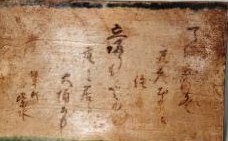
Pottery plaque with the 5th year of Tempo (Kato family collection)

Knot style water jug
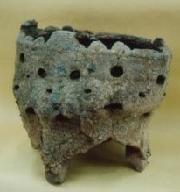
The sayabee used to make Tamagawa ware
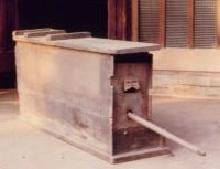
Fuigo used to make Tamagawa ware
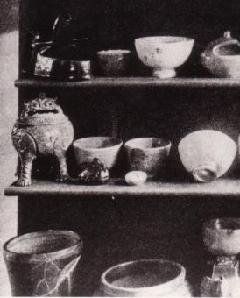
Tamagawa ware collected by Dr. Morse (five items on the left side of the middle row)
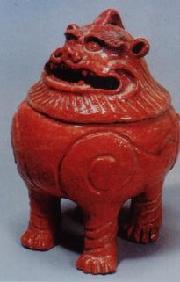
Large lion-shaped incense burner
Inagi City Education Department Lifelong Learning Division Tel: 042-377-2121